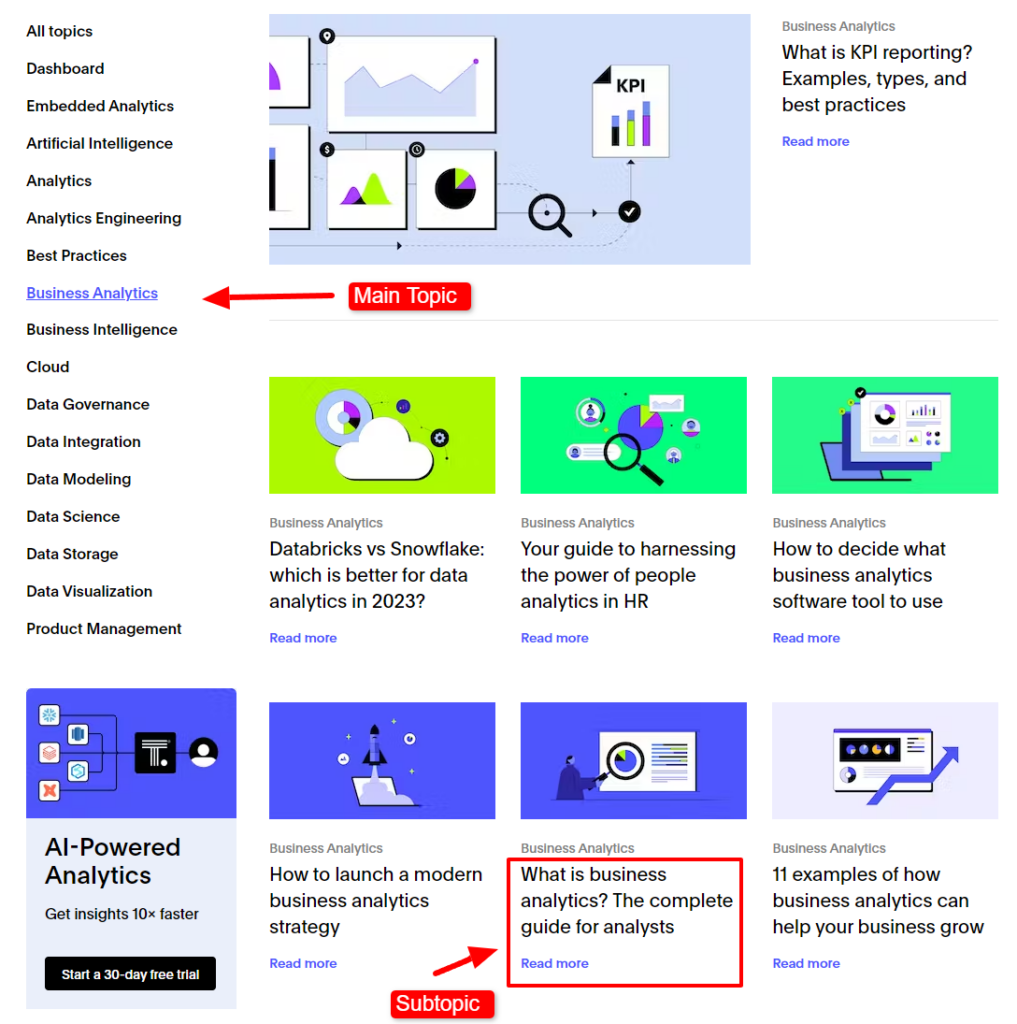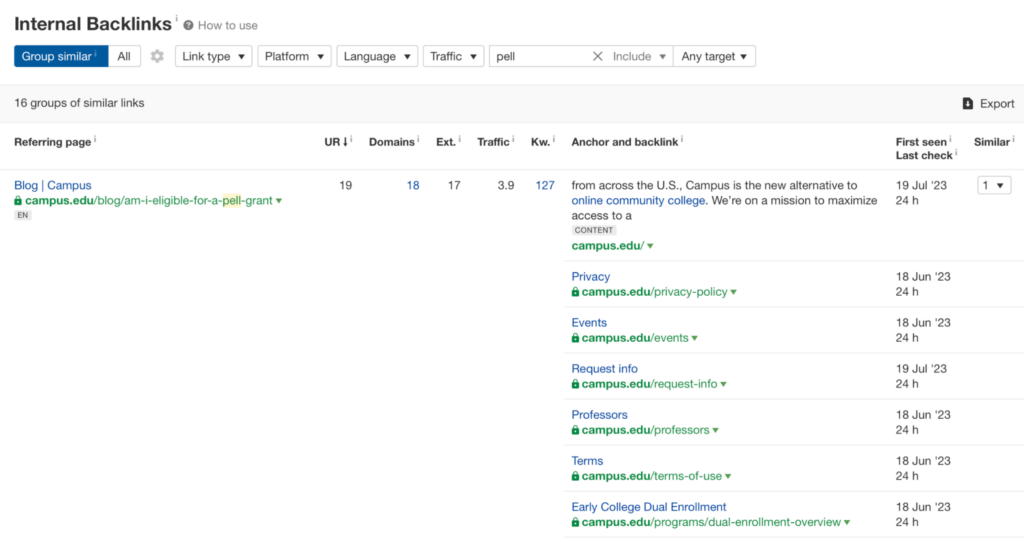Content Clusters and Topic Authority: A Comprehensive Guide to SEO Dominance
Creating a topic cluster model as part of your SEO strategy is one of the best ways to draw in your ideal audience. That is, as long as you know their search intent and the solutions you can offer to fix their problems.
Beyond producing quality content, your target audience needs specific information. They’re interested in certain core topics and related topics that can bring high value to their lives and businesses.
That’s why it’s pivotal to have a content cluster strategy.
If you’re ready to build topical authority and create a content strategy that magnetizes your ideal audience, keep reading.
In this article, we’re covering what content clusters are and why they matter. We’re also walking you through how to create clusters of content, step by step.
Let’s get started!
What are content clusters, and why do they matter?
Think of a content cluster as a “content hub”, if you will.
In other words, imagine each cluster targets a broad topic with relevant subtopics parked underneath. Each cluster also targets a specific audience segment.
For instance, if you’re in the luxury fashion industry, you might create clusters for the following audience segments:
- People who love men’s luxury fashion
- People who love women’s luxury fashion
- People who love unisex luxury fashion
Or, if you’re in the luxury suits for men subsector, you might create clusters for people who love men’s luxury suits but have different needs.
For instance, one segment might need fashion tutorials (think how-tos and what-to-wears), another segment may be looking for suit care and maintenance instructions, and a third may be searching for suit styling tips.
Consider the case of StudioSuits, a brand renowned for its expertise in crafting customized men’s suits. By meticulously curating content topics its niche audience craves (spanning from styling and fashion guides to care tips and tailoring techniques), StudioSuits has seamlessly woven a web of information on men’s suits.
This approach not only caters to its audience’s diverse needs and queries but also establishes the brand as the go-to authority in custom men’s fashion.
The beauty of content clusters also lies in their ability to interlink related pieces, creating a comprehensive knowledge hub.
When a user seeks advice on selecting the perfect men’s suit, they may stumble upon StudioSuits’ detailed guide. As they explore further, they’ll encounter articles on fabric choices, fitting tips, and the latest fashion trends — all seamlessly linked. This enhances the user experience and signals to search engines that StudioSuits has in-depth expertise on the subject.
The result?
Elevated search engine rankings, increased organic traffic, and a loyal customer base that recognizes StudioSuits as the ultimate source for all things custom men’s suits.
The power of content clusters in building topical authority is undeniable, and StudioSuits serves as a prime example of how this strategy can lead to SEO dominance in the competitive world of online commerce.
In fact, at the time of this writing, Studio Suits landed the fourth organic keyword ranking position for the search query “tweed jacket” and “custom men’s suits”. It also landed the eighth organic ranking position for the keyword phrase “men’s suits styling tips”.
Identify your target audience and the pain points your business helps solve
Now that we’ve covered the basics, it’s time to work through the steps to create your own content clusters.
And for this first step, you need to hone in on your target audience.
So…
Who do you help and why? What segments do you cater to?
What common questions and pain points do they have? How do you solve them?
Use this information to brainstorm long-tail keywords and topic themes that could work as pillar posts and topics in your content clusters. If you’ve been in business for a while, you can also review past form submissions and documented customer support tickets to uncover FAQs and common pain points.
For instance, if you target SaaS companies and you sell AI-powered chatbot software, then your audience segments might have the following pain points and questions:
Pain points
- Segment 1 – Project management SaaS companies: Trouble ticketing software managing endless sales form and demo form inquiries
- Segment 2 – Ecommerce SaaS companies: Overwhelmed by customer support tickets
- Segment 3 – SaaS companies that offer Free-Forever plans: Craving more guided selling options to reduce bounce rates and personalize plan upgrades
Questions
- Segment 1: How can an AI-powered chatbot help me manage sales inquiries?
- Segment 1: Can chatbots help me book and manage demos?
- Segment 2: Can I use AI-powered chatbots to manage customer support?
- Segment 2: What levels of customer support can chatbots help with?
- Segment 3: How can AI chatbots help my website become a lead-generating machine?
- Segment 3: How can chatbots help my site guide users to conversion?
With these insights in mind, you might have brainstormed the following list of keywords:
- Too many inquiries
- Sales form inquiries
- Demo form inquiries
- Trouble managing inquiries
- Customer support tickets
- Customer support overwhelm
- Guided selling options
- Reduce bounce rates
- Personalize plan upgrades
- Manage sales inquiries
- Book and manage demos
- Book demos
- Manage demos
- Customer support can chatbots help
- Customer support chatbots
- Chatbots lead-generation
- Chatbots sales conversion
- AI chatbot support for SaaS
- AI chatbots for SaaS companies
- What are AI chatbots
- How AI chatbots help sell
- How AI chatbots help collect leads
- Chatbots for SaaS
Finalize your main topics and subtopics
Use a keyword research tool to finalize your main topics. Refer to your brainstorming list from above and plug each option into the tool.
Unless you’ve already earned a high domain authority score, cross out any term on your list that’s a highly competitive keyword, even if it’s a relevant keyword or has a high search volume. Without the proper authority, trying to rank for keywords like these will be next to impossible.
Instead, use your keyword tool to uncover which terms on your list have low competition and a high search volume.
These terms give you the best chance at attracting your target audience in a low-stakes environment.
After you’ve finalized your main topics, use the “More to ask” and “More searches” sections in Google to uncover relevant subtopics for each theme. Google also calls these sections “People also ask” and “Related searches,” depending on the search query.

For instance, take a look at ThoughtSpot’s main topics and subtopics:

If you look to the far left in the above image, you’ll notice it covers pillar topics, such as Analytics, Business Analytics, Data Governance, and Data Science, among others.
If you click on a main topic, it’ll bring up a page with relevant subtopics.
For instance, if you choose “Business Analytics”, you’ll see types of business analytics, examples, tools, and how-tos as subtopics, such as:
- What is business analytics? The complete guide for analysts
- Your guide to harnessing the power of people analytics in HR
- How to decide what business analytics software tool to use
- 11 examples of how business analytics can help your business grow
With these insights in mind, it’s time to finalize your cluster topics!
Remember:
- Hone in on your target audience and customer segments
- Identify each segment’s pain points
- Refer to their pain points and FAQs to brainstorm main topics
- Use your keyword research tool to finalize main topics with high search volume and low competition
- Use the People Also Ask and Related searches sections in Google to find and finalize subtopics
- Create your content cluster! Keep reading to find out how
Here’s a simple template you can use to plan your content clusters:
Content Cluster 1 – Target Audience Segment: (Enter Segment)
- Pillar Topic:
- Subtopic 1:
- Subtopic 2:
- Subtopic 3:
Content Cluster 2 – Target Audience Segment: (Enter Segment)
- Pillar Topic:
- Subtopic 1:
- Subtopic 2:
- Subtopic 3:
Content Cluster 3 – Target Audience Segment: (Enter Segment)
- Pillar Topic:
- Subtopic 1:
- Subtopic 2:
- Subtopic 3:
Content Cluster 4 – Target Audience Segment: (Enter Segment)
- Pillar Topic:
- Subtopic 1:
- Subtopic 2:
- Subtopic 3:
Content Cluster 5 – Target Audience Segment: (Enter Segment)
- Pillar Topic:
- Subtopic 1:
- Subtopic 2:
- Subtopic 3:
Produce your content
Work on the pieces you’ll publish on your pillar pages first, then on the ones you’ll publish on your subtopic pages.
Optimize each piece according to the target pillar keyword or target subtopic keyword.

Use copywriting and optimization best practices to give your pieces the best chance of ranking.
For instance,
Copywriting tips:
- Bring the reader’s eye down with proper formatting, short and snappy sentences, and bucket brigades
- Use conversational-style writing
- Include high-value information your audience cares most about
- Include examples whenever you reference information
- Infuse case studies, stats, and expert quotes if relevant
- Give your audience actionable advice that can bring tremendous value to their lives or business
Optimization tips:
- Add relevant semantic keywords (based on the target keyword) to each pillar piece and subtopic piece you create — weave these in naturally
- Aim for a topic score that’s higher than the average competitor score
- Check out SEO tools, such as Frase, Clearscope, and MarketMuse
- Apply Google’s E-E-A-T principle
- Link to high-authority external sources
- Add an FAQ section to each piece
- Add a Table of Contents section to each piece
- Use bulleted lists and value-driven images to break up large chunks of text and help pull the reader’s eye down
- Use meta titles, meta descriptions, image titles, and alt descriptions
- Perform a content gap analysis when preparing your content briefs
Publish your content and connect your content clusters
Set up your pillar pages and your subtopic pages on your website. Then, publish your pieces on the appropriate pages. Connect everything together with internal links.
Here’s how…
Cluster One Example Structure
Pillar page: Paste your main pillar piece and add links to subtopic pieces. Embed your subtopic links throughout the pillar content piece itself where relevant. Add a separate section on the pillar page that says, “Read more about (main topic here) with the following articles (links to subtopic pages)”.
- Subtopic page 1: Paste your subtopic piece 1 here and add internal links to other pieces within the cluster (embed them in the content where natural and as a section on the subtopic page that reads “Next article: (link to Subtopic 2)”
- Subtopic page 2: Paste your subtopic piece 2 here and add internal links to other pieces within the cluster (embed them in the content where natural and as a section on the subtopic page that reads “Next article: (link to Subtopic 3)”
- Subtopic page 3: Paste your subtopic piece 3 here and add internal links to other pieces within the cluster (embed them in the content where natural and as a section on the subtopic page that reads “Next article: (link to Subtopic 1)”
For instance, consider Campus.edu, a community college with a blog focusing on ways students can secure grants and financial aid, including Pell Grants. Within its financial aid articles, it strategically incorporates links to admissions programs and career paths.
This strategic internal linking not only enhances the user experience but also earns favor with search engine indexers, boosting its SEO performance:

Wrap up
Content clusters and topical authority go hand in hand when you take the time to set up your topics and subtopics properly.
That means using…
- Your audience segments to uncover pain points and relevant main topics
- Keyword tools to focus on pillar topics with high search volume and low competition
- The People Also Ask and Related searches sections in Google to uncover subtopics
- Internal linking strategies to connect your main topics with your subtopics
After publishing your pieces on relevant pages and setting up your internal links, be sure to keep an eye on your content clusters. Continue refining and updating your content as you learn new insights about your target audience’s needs and behaviors.
If you’re feeling overwhelmed by these steps, consider letting SEO experts take over. In fact,
you’ll love our award-winning SEO agency, Pearl Lemon. Book a call with us to find out how we can help you build out your cluster strategy. 🍋
Here’s to your success!









